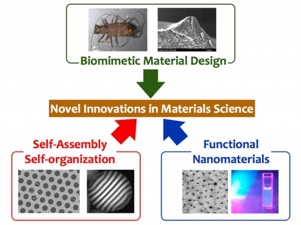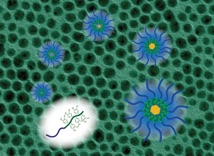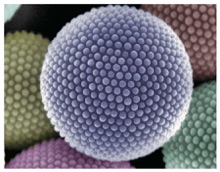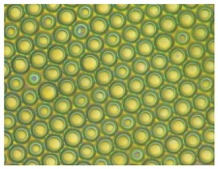
Based on polymer chemistry and nanomaterials science, learning from and integrating with living organisms toward materials that surpass living organisms
Living organisms have acquired various functions in the process of evolution and have selected through the competition for survival. We extract the principles of these biological functions (especially surface functions) and obtain hints for the development of new materials from them.
For example, the superhydrophobicity of lotus leaves can be used for stain-free surface coatings, the structural color of the morpho butterfly can be used to develop paints that do not degrade, the sticky hand of a gecko can be used to develop an adhesive that can be applied and removed….etc.
All of these functions are achieved through a combination between the various chemicals secreted by organisms and their surface structures. The strategy of using structure can be considered an effective strategy adopted by organisms to make effective use of limited resources. In addition, organisms form these materials and structures by self-assembly and self-organization of macromolecules composed of a limited number of elements, such as proteins and sugars.
On the other hand, humans have invented and used various functional materials from a wide variety of resources since the beginning of history. By using elements and compounds that cannot be utilized by living organisms, we have developed materials with various properties. For example, fluorine coatings for water repellency and multilayer films for glass lenses have been achieved using elements and processes that are not available to living organisms.
Therefore, if we can combine artificial materials with extremely high functionality and performance with structural designs used by living organisms, we should be able to develop new materials never seen before.
In our laboratory, based on (1) hints obtained from living organisms (material design), (2) synthetic materials such as nanomaterials and functional polymers, and (3) low-energy processes of self-assembly and self-assembly, we will learn from living organisms (Biomimetic), integrate with them (Biohybrid), and ultimately combine artificial materials with living organisms (Biohybrid). Our goal is to create materials that transcend living organisms (Metabio) by biological design.
Synthesis of Polymers and Nanomaterials

We synthesized new amphiphilic random/block polymers having functional moieties including photo-responsive, theremo-responsive and adhesive groups and these synthesized polymers were applied to fabrication of honeycomb films, functional polymer particles, and templates for metal nanoparticles.
Chemical Communications, 51(18), 3743-3746 (2015) link
Honeycomb Films and Their Applications

Honeycomb films, which are porous films fabricated by breath figure technique, have been developed. Fabrication processes and applications of honeycomb films such as superhydrophobic surfaces, cell culturing substrates, porous electrodes and so on have been demonstrated.
Soft Matter,10(16), 2741- 2747 (2014)link
Biomaterials Science, 2(1), 52-56 (2014)link
Langmuir, 21(8), 3235-3237 (2005) link
Polymer Particles Prepared by “SORP”

Self-ORganied Precipitation (SORP) technique, which is our original polymer particle preparation method, allows formation of particles from functional polymers, block copolymers and polymer blends. Furthermore, interior structures of particles can be controlled by phase separation of polymers. Organic-inorganic hybridization realized creation of functional particles.
Advanced Materials,17(17), 2062-2065 (2005) link
Soft Matter, 4(5), 1302-1305 (2008) link
Macromolecular Rapid Communications, 31(14), 1267-1271 (2010) link
Biomimetic Material Design

Biomimetic or biomimicry is one of the important philosophy to design new materials. We developed various functional materials based on biomimicry concepts.
Advanced Functional Materials, 25(27), 4195-4201 (2015).
Langmuir, 31(3), 959-963 (2015) link
Langmuir, 30(47), 14118-14122 (2014) link
Electrocatalysts -Toward metabio materials-
Heme iron, the active site of hemoglobin that carries oxygen in our blood, is an iron complex, and oxygen is transported by adsorption and desorption of oxygen on iron. A man-made substance with a similar structure is iron phthalocyanine, known as the blue pigment of the bullet train.
When a voltage is applied to carbon with an iron phthalocyanine analog, iron azaphthalocyanine, adsorbed on it, it was found to act as a catalyst to reduce oxygen and convert it to hydroxide ions. Oxygen Reduction Reaction (ORR) is a cathode reaction in fuel cells and metal-air batteries, and platinum-carbon (Pt/C) catalysts have been conventionally used. However, the iron azaphthalocyanine monolayer (Fe AZUL) catalyst we have discovered has higher activity and stability than Pt/C.
Based on this knowledge, we have established AZUL Energy, Inc., a startup company spun out from Tohoku University, to promote the practical use of AZUL catalysts and to develop their performance and applications.
World wide collaboration
We collaborate with many other domestic and international research groups including USA, UK, France, Germany, Korea, etc.
If you are interested in these researches, please contact to Prof. H. Yabu.
